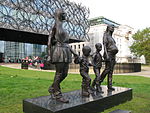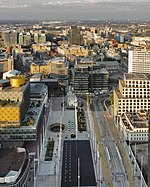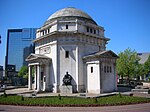Birmingham Municipal Bank headquarters

The former headquarters of the Birmingham Municipal Bank is a Grade II listed building by Thomas Cecil Howitt opposite what is now Centenary Square at 301 Broad Street, Birmingham, England. The building was opened on 27 November 1933 by Prince George. The BMB ceased to be a department of the city council in 1976, becoming a trustee savings bank,After the bank vacated the building, it was sold in 2006 to Birmingham City Council. The building was granted grade II listed status on 14 October 1996.In November 2017, the University of Birmingham completed the purchase of the Municipal Bank building. It is planned to create a city centre showcase to display its research and host performances and exhibitions.
Excerpt from the Wikipedia article Birmingham Municipal Bank headquarters (License: CC BY-SA 3.0, Authors, Images).Birmingham Municipal Bank headquarters
Centenary Square, Birmingham Ladywood
Geographical coordinates (GPS) Address Nearby Places Show on map
Geographical coordinates (GPS)
| Latitude | Longitude |
|---|---|
| N 52.478555555556 ° | E -1.9075944444444 ° |
Address
The Exchange University of Birmingham
Centenary Square
B1 2DR Birmingham, Ladywood
England, United Kingdom
Open on Google Maps










